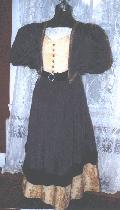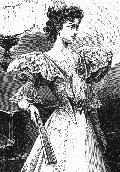
|
ca. 1895 silk evening dress, eggplant colored moire bengaline and yellow
damask. This gown was inspired by an illustration in Harper's Bazar
ca. 1896.
This photograph of Idy was taken at the Astors' Beechwood Mansion during the February 2000 Grand Victorian Ball. |

|
This gown was made for use as a performing gown for a member of The Commonwealth Vintage Dancers. The prescribed era was 1893-96, with large puffed sleeves and jewel tone colors. The dress is primarily eggplant (plum) colored bengaline, with contrast panels of yellow damask. The trim is of purple velvet, with grey silk lining. The jacket and sleeves are trimmed with gold metallic lace. |

|
Materials used (all modern except for buttons):
|

|
Idy came to me with the gold damask -- and wanted to use green with it, but as there already was a green and cream gown in the dance troupe we decided to find a different combination. We settled on the eggplant bengaline fairly quickly. It is a very striking combination. It came from Zimman's, a home furnishing fabric store in Lynn, MA. Their selection, especially of home decor silks, is to die for for any clothaholic. If you are in the Boston area I highly recommend you try and visit them. |

|
Our first source of inspiration was this Harper's Bazar design from January 1, 1896. It gave us the inspiration for the jacket front. We decided to make the gown more tailored by eliminating the lace ruffles and jabot and replacing it with a simple gathered chiffon under-bodice, edged with yellow embroidery and topped with a tailored waistcoat. |

|
We also added some "historical" influences with the gold lace trim, which makes it look somewhat 17th century inspired. Making gowns look historical was a big thing in the 1890's, they loved to make things look old-fashioned. The sleeve, which is rather heavy, is supported with a crinoline net ruffle attached to the sleeve lining. |

|
The bodice was made using a pattern adapted from Janet Arnold's Patterns of Fashion: Volume II, 1890's evening bodice (pp 44), with somewhat enlarged sleeves. The jacket false-front pattern was designed by draping it on the body using the bodice front pattern as a starting point. The back peplum was adapted from a jacket pattern found in a Harper's Bazar pattern sheet. |

|
The skirt was made using Past Patterns #1097, Huguenot Skirt (from their Vintage Revival Patterns selections). |

|
The waistcoat front is of upholstery damask and has period metal buttons with cut steel detailing. |

|
The front waist is defined by a velvet sash with rhinestone buckle. |

|
The back bodice has a peplum, edged with lace and topped with a large velvet bow at the waist. The vest, sash, bow, and hem trimming are all lined with grey silk. |

|
The skirt is of bengaline with the yellow damask, patterned in a large Renaissance style floral pattern, at the bottom. The join is decorated with velvet swags. This creates the effect of an overskirt. The hem is finished with large self-piping. The skirt is lined with 200 count cotton sheeting and the back panels and front hem are stiffened with hair canvas, and the hem is finished with a wide hem facing. |